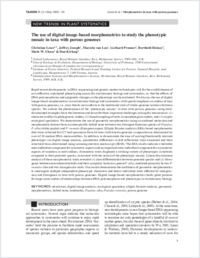The use of digital image-based morphometrics to study the phenotypic mosaic in taxa with porous genomes
- Lexer, Christian Jodrell Laboratory, Royal Botanic Gardens, Kew, U.K., - Unit of Ecology & Evolution, Department of Biology, University of Fribourg, Switzerland
- Jeffrey, Joseph Jodrell Laboratory, Royal Botanic Gardens, Kew, U.K.
- Loo, Marcela van Unit of Ecology & Evolution, Department of Biology, University of Fribourg, Switzerland
- Prenner, Gerhard Unit of Ecology & Evolution, Department of Biology, University of Fribourg, Switzerland
- Heinze, Berthold Institute of Forest Genetics, Federal Research and Training Centre for Forests, Natural Hazards, and Landscape, Vienna, Austria
- Chase, Mark W. Unit of Ecology & Evolution, Department of Biology, University of Fribourg, Switzerland
- Kirkup, Don Identification Systems and Morphometrics Section, Herbarium, Royal Botanic Gardens, Kew, U.K.
-
2009
Published in:
- Taxon. - 2009, vol. 58, no. 2, p. 349-364
English
Rapid recent developments in DNA sequencing and genetic marker technologies call for the establishment of cost-effective, automated phenotyping assays for evolutionary biology and systematics, so that the effects of DNA polymorphisms and epigenetic changes on the phenotype can be evaluated. We discuss the use of digital image-based morphometrics in evolutionary biology and systematics with special emphasis on studies of taxa with porous genomes, i.e., taxa that do not conform to the traditional view of whole-genome isolation between species. We outline the phenomenon of the 'phenotypic mosaic' in taxa with porous genomes using well-documented examples from the literature and describe three important challenges arising for taxonomists: (1) character conflict in phylogenetic studies, (2) biased sampling of traits in morphological studies, and (3) cryptic ecological speciation. We demonstrate the use of geometric morphometrics using a combined molecular and morphometric dataset from an interspecific hybrid zone between two divergent Eurasian species of Populus, P. alba (white poplar) and P. tremula (European aspen). Elliptic Fourier analysis (EFA)-based morphometric data were collected for 527 leaf specimens from 84 trees with known genomic composition as determined by a set of 30 nuclear DNA microsatellites. In addition, to demonstrate the ease of scoring functionally relevant phenotypes via digital image analysis, quantitative differences in leaf reflectance were examined and their structural basis determined using scanning electron microscopy (SEM). The EFA results indicate a heritable inter-individual component for symmetric aspects and an important intra-individual component for asymmetric aspects of variation in leaf outlines. Symmetric traits displayed a striking variety of phenotypes in hybrids compared to their parental species, consistent with the notion of the phenotypic mosaic. Linear discriminant analysis of these morphometric traits revealed (1) clear differentiation between parental species and (2) divergence between recombinant hybrids and their sympatric backcross parent P. alba, mediated primarily by two P. tremula-like and two transgressive traits. Our results demonstrate the usefulness of geometric morphometrics to interrogate multiple independent phenotypic characters and detect individual traits affected by introgression and divergence in taxa with porous genomes. Digital image-based morphometrics holds great promise for large-scale studies of relationships between DNA polymorphism and phenotypes in evolutionary biology.
- Faculty
- Faculté des sciences et de médecine
- Department
- Département de Biologie
- Language
-
- English
- Classification
- Botany
- License
-
License undefined
- Identifiers
-
- RERO DOC 12943
- DOI 10.1002/tax.582003
- Persistent URL
- https://folia.unifr.ch/unifr/documents/301312
Statistics
Document views: 130
File downloads:
- pdf: 359
